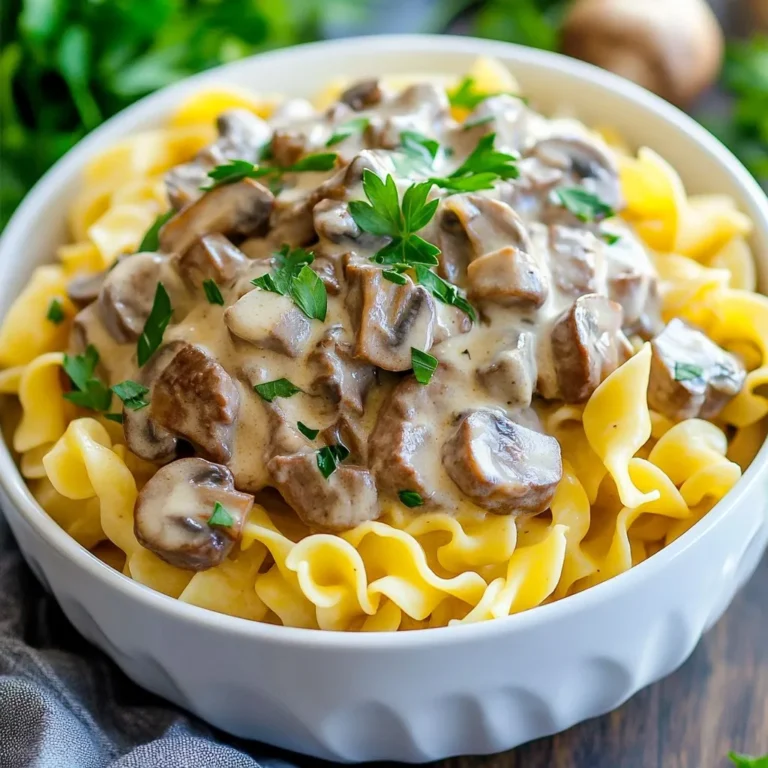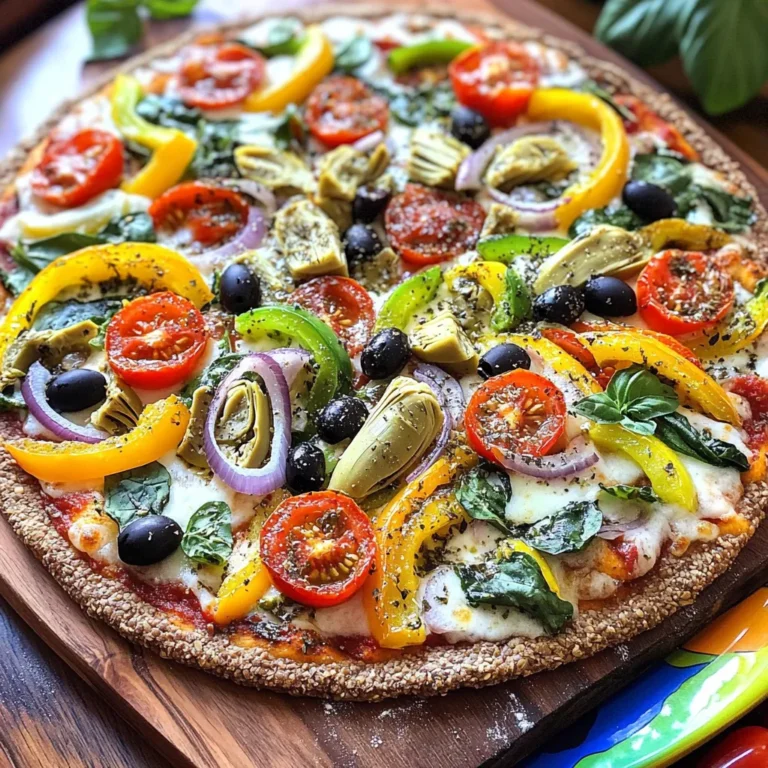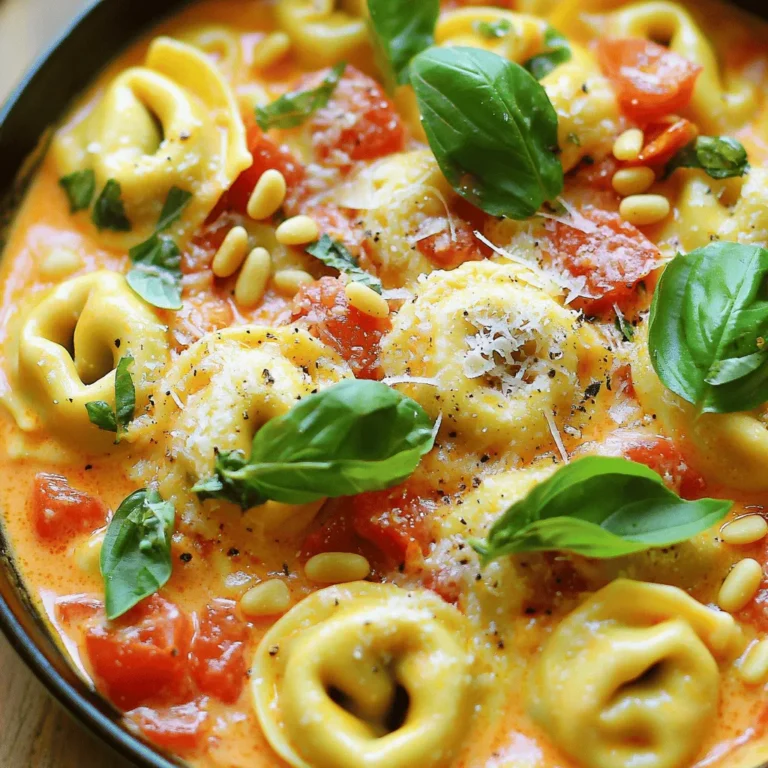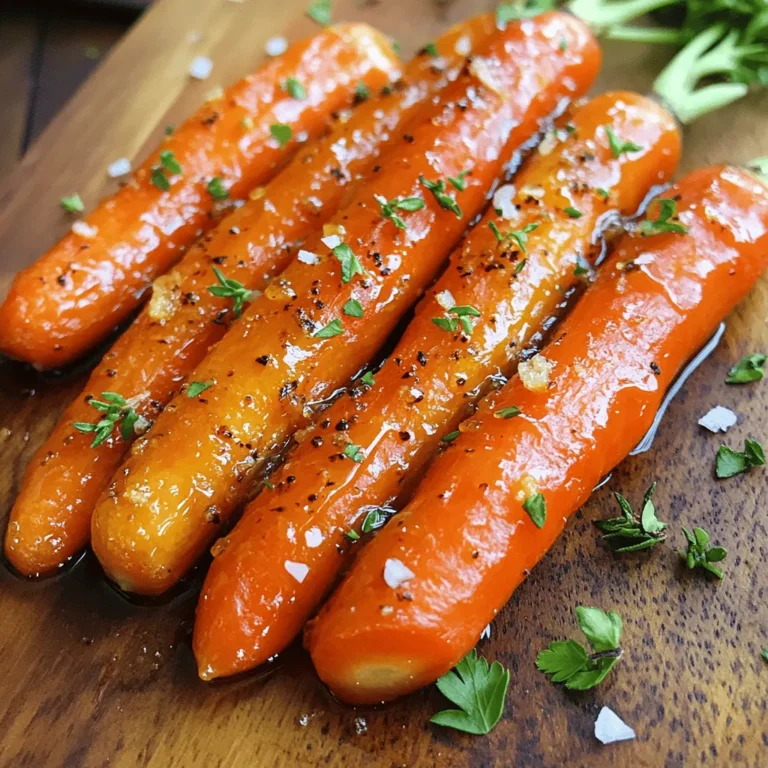Vegetable Curry with Chickpeas Tasty and Simple Dish

Looking for a quick and tasty meal that’s also healthy? My Vegetable Curry with Chickpeas is just what you need! Packed with vibrant veggies and creamy coconut milk, this simple dish is sure to please. Plus, you can easily customize it to suit your taste. Follow me as we dive into the ingredients, cooking steps, and tips to make this flavorful curry right at home!
Ingredients
List of Main Ingredients
- 1 can (15 oz) chickpeas, drained and rinsed
- 1 medium onion, finely chopped
- 3 cloves garlic, minced
- 1-inch piece of ginger, minced
- 1 medium carrot, diced into small cubes
- 1 bell pepper (your choice of color), chopped into bite-sized pieces
- 1 zucchini, diced into half-moons
- 1 cup cauliflower florets (fresh or frozen)
- 1 can (14 oz) creamy coconut milk
- 2 tablespoons curry powder
- 1 teaspoon ground cumin
- 1 teaspoon turmeric powder
- 1 tablespoon olive oil
- Salt and freshly ground black pepper to taste
- Fresh coriander leaves for garnish
- Lime wedges, for serving
Optional Ingredients
- Additional vegetables (e.g., spinach, peas)
- Different protein options (like tofu or meat)
- Alternative herbs for garnishing
When I create my vegetable curry with chickpeas, I love using fresh ingredients. Fresh veggies make a big difference in taste. You can mix and match the vegetables based on what you have. Try adding spinach or peas for a pop of color and flavor. If you want, you can swap chickpeas for lentils or even add tofu for extra protein. Remember, cooking is about fun and creativity!
For the best flavor, I recommend using high-quality coconut milk. It adds creaminess and richness to the dish. Don’t forget to adjust the spices too. If you love heat, add more curry powder or a pinch of cayenne pepper.Enjoy cooking!
Step-by-Step Instructions
Cooking Method
- Heat 1 tablespoon of olive oil in a large pot over medium heat.
- Add 1 finely chopped medium onion and sauté for about 5 minutes.
- Once the onion is soft, add 3 minced garlic cloves and 1 inch of minced ginger.
- Stir often for 2 minutes until you smell their wonderful aroma.
- Now, add your chopped vegetables: 1 medium carrot, 1 bell pepper, and 1 zucchini.
- Sauté everything for 5-7 minutes until the veggies start to soften.
Seasoning and Simmering
- Next, add 1 cup of cauliflower florets, 2 tablespoons of curry powder, 1 teaspoon of cumin, and 1 teaspoon of turmeric.
- Stir well and toast the spices for 2 minutes. This step makes the flavors pop!
- Carefully pour in 1 can (14 oz) of creamy coconut milk and add the rinsed chickpeas.
- Mix everything gently, then bring it to a gentle simmer on low heat.
- Let it simmer uncovered for about 15-20 minutes. Stir occasionally. This helps the curry thicken nicely.
Final Touches
- Taste your curry and season it with salt and pepper to your liking.
- Once done, remove the pot from heat.
- Garnish with fresh coriander leaves. Serve with lime wedges for a zesty kick.
Tips & Tricks
Perfecting the Flavor
To make your curry just right, adjust the spice levels. If you like it spicy, add more curry powder. For a milder dish, cut back on the spices. Start with two tablespoons and add more if you like.
Simmering the curry is key for great flavor. It allows the spices to blend well with the veggies. Let it cook on low heat for at least 15 minutes. This way, all the tastes meld together, making each bite special.
Serving Suggestions
Pair your vegetable curry with rice or naan. Both options soak up the tasty sauce. Serve the curry in deep bowls for a nice look.
To make your dish appealing, garnish it well. A sprig of fresh coriander adds color. Place lime wedges on the side for a zesty kick. This makes the meal look and taste fresh.
Kitchen Tools
Using the right kitchen tools makes cooking easier. A large pot or deep skillet is best for this dish. It helps cook all the veggies evenly.
I recommend a non-stick skillet. It prevents sticking, making cleanup simple. Plus, it requires less oil, which is great for health. You can find these tools in most kitchens.
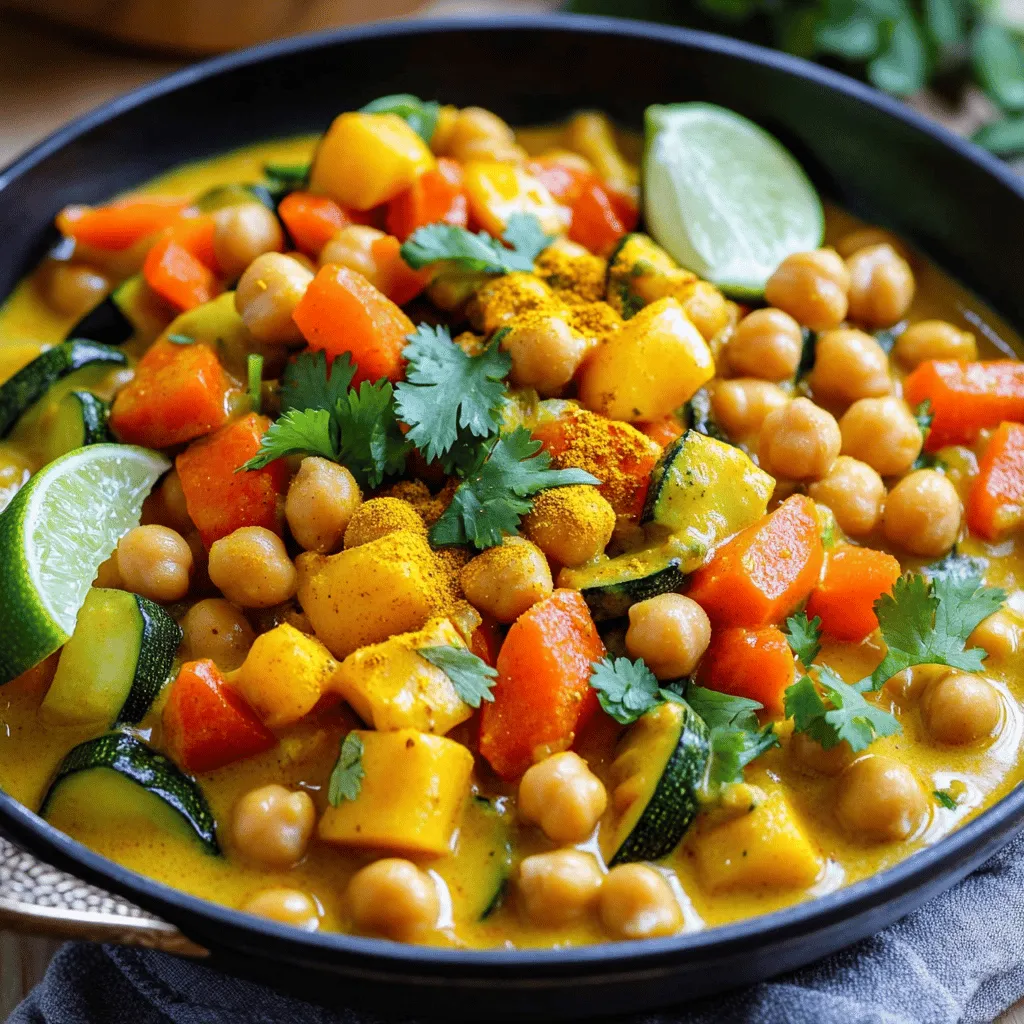
Variations
Ingredient Swaps
You can switch up the legumes in this recipe. Lentils are a great choice. They cook quickly and add protein. You could also use black beans or kidney beans for a different taste.
If you want a creamier texture, try plant-based milk. Almond milk or oat milk can replace coconut milk. They will change the flavor but keep the dish delightful.
Cuisine Inspiration
For a Thai twist, add some fresh basil or cilantro. Use red curry paste instead of curry powder for depth. Toss in a splash of lime juice for brightness.
If you prefer Indian flavors, add garam masala or cardamom. You can include peas or potatoes for heartiness. Serve with rice or naan for a complete meal.
Dietary Adaptations
This recipe is gluten-free as it stands. Just make sure to check your curry powder for gluten.
If you’re vegan, this dish is perfect for you. For vegetarians, you can add yogurt on top for creaminess. Both options offer tasty experiences without losing flavor.
Storage Info
Refrigeration Guidelines
To keep your vegetable curry fresh, store it in an airtight container. Let it cool first. This keeps bacteria at bay. You can safely eat it within 3 to 5 days. If you notice any off smells or changes in color, toss it out.
Freezing Tips
You can freeze the vegetable curry for longer storage. Use a freezer-safe container or a heavy-duty freezer bag. Make sure to leave some space for expansion. When you’re ready to eat, thaw it in the fridge overnight. For a quick option, you can microwave it on low.
Serving After Storage
To reheat, use a pot over low heat. This keeps the flavors intact. Stir often to prevent sticking. You might notice changes in texture, especially with the veggies. To help, add a splash of water or coconut milk while reheating. This restores creaminess and moisture to the dish. Enjoy your meal as if it was fresh from the stove!
FAQs
What to serve with Vegetable Curry with Chickpeas?
You can serve vegetable curry with chickpeas alongside rice or naan. Both pair well with the creamy sauce. I like to serve it with fluffy basmati rice. You can also add a side salad for a fresh crunch. Yogurt or raita adds a great cooling effect, too.
How long does Vegetable Curry with Chickpeas last in the fridge?
Vegetable curry with chickpeas can last up to five days in the fridge. Store it in an airtight container to keep it fresh. Just make sure it cools down before you put it in the fridge.
Can I make Vegetable Curry with Chickpeas in advance?
Yes, you can make vegetable curry with chickpeas ahead of time. Cooking it a day before allows the flavors to blend. Just reheat it on the stove before serving.
What are the best spices to enhance curry flavor?
To enhance your curry, you might use:
- Curry powder
- Ground cumin
- Turmeric
- Coriander
- Cinnamon
These spices add depth and warmth to your dish. Feel free to adjust based on your taste.
Are there any common allergens in this recipe?
This recipe includes chickpeas and coconut milk, which can be allergens. Always check for any nut allergies, as some coconut products may contain traces. If you cook for others, ask about their allergies first.
This blog post shared a simple vegetable curry recipe with chickpeas. We covered key ingredients, easy cooking steps, and handy tips for flavor. I also explored variations and storage options. This dish is flexible; adapt it to fit your tastes. Remember, cooking is a way to express yourself. Enjoying your meal is what matters most. Try this curry and make it your own!


![To make Indian-spiced chickpea stew, you need fresh and flavorful ingredients. This stew brings warmth and comfort to your table. Here’s what you’ll need: - Canned chickpeas: 2 cups, thoroughly drained and rinsed - Vegetables and aromatics: - 1 medium onion, finely chopped - 2 cloves garlic, minced - 1 tablespoon fresh ginger, grated - Spices and liquids: - 1 can (14 oz) diced tomatoes with juice - 1 can (14 oz) coconut milk - 2 cups vegetable broth - 1 tablespoon curry powder - 1 teaspoon ground cumin - 1 teaspoon turmeric powder - 1/2 teaspoon red chili powder (adjust according to your heat preference) - 1 tablespoon olive oil - Salt and freshly ground black pepper, to taste - Fresh cilantro, chopped (for garnishing) These ingredients create a rich base for your stew. The chickpeas provide protein and texture. The diced tomatoes add acidity and sweetness. Coconut milk gives a creamy touch. Each spice brings its own unique flavor. You can find the full recipe [here]. Enjoy cooking! 1. Sautéing the aromatics Start by heating olive oil in a large pot over medium heat. Add the chopped onion and cook until it turns soft and golden. This should take around five minutes. Then, mix in minced garlic and grated ginger. Cook for one more minute, stirring often. You want to smell the lovely aroma from the garlic and ginger. 2. Adding spices and liquids Next, sprinkle in the curry powder, ground cumin, turmeric powder, and red chili powder. Stir until the onion is coated with these spices. Let them cook for two minutes. This step makes the flavors pop! Now, pour in the diced tomatoes with their juice, followed by the creamy coconut milk and vegetable broth. Mix everything well to combine. 3. Simmering the stew Gently fold in the rinsed chickpeas. Add salt and black pepper to taste. Bring the stew to a gentle simmer. Once simmering, lower the heat, cover the pot, and let it cook for 20 to 25 minutes. Stir occasionally to keep it from sticking. After cooking, taste and tweak the seasoning. If you want it thicker, mash a few chickpeas against the pot. Garnish with fresh cilantro before serving. Enjoy your delicious Indian-spiced chickpea stew! For the full recipe, refer back to the ingredients section. - Ensuring the perfect texture: To get that creamy and thick stew, you should mash some chickpeas. This adds a nice body. Stir gently while mashing to keep some whole. - Adjusting spice levels: If you want more heat, add more red chili powder. Start with a little, then taste and add more if needed. For less spice, cut the chili powder in half. - Enhancing flavor with garnishes: Fresh cilantro adds color and brightness to the stew. Just chop it up and sprinkle it on top before serving. You can also add a squeeze of lime for extra zing. These tips will help you craft a comforting dish. For the complete cooking process, check the Full Recipe. {{image_4}} You can easily change this stew to fit your taste. - Using different legumes or vegetables: If you don’t have chickpeas, try black beans or lentils. You can also add sweet potatoes, carrots, or spinach for more nutrients. - Dairy-free options: The coconut milk gives a rich taste, but you can swap it with almond or soy milk. This keeps the stew creamy without dairy. - Additional spices to suit taste: If you want more heat, add cayenne pepper or fresh chili. For a different flavor, try garam masala or coriander. Play around with spices to find your perfect blend. Feel free to explore these options! Every change can make your stew unique and delicious. Want to try the original? Check out the Full Recipe for the classic dish. To keep your Indian-spiced chickpea stew fresh, let it cool first. This step is key. Place the pot on a cool surface. Give it about 30 minutes to reach room temperature. Use airtight containers for storage. Glass containers work well. They keep the flavors locked in. You can also use plastic containers, but make sure they are BPA-free. When ready to reheat, take the stew from the fridge. Pour it into a pot. Heat it on medium-low. Stir often to stop it from sticking. If it seems thick, add a splash of vegetable broth or water. Heat until it's warm, about 5 to 10 minutes. For safe eating, ensure it reaches at least 165°F. This way, you'll enjoy the stew's warmth and flavor again! For the full recipe, check out the Spicy Indian Chickpea Stew 🥘. Yes, you can freeze this stew. Let it cool first. Then, put it in a safe container. Leave some space at the top for expansion. It stays good for about three months. To thicken your stew, mash some chickpeas. Use the back of a spoon against the pot. You can also simmer it longer. This helps reduce the liquid and makes it thicker. You can serve this stew with rice or naan. Both soak up the flavors well. A side salad or yogurt adds a nice touch too. Enjoy experimenting with different pairings! For the complete recipe, check out the [Full Recipe]. This blog post covered how to make a tasty Indian-spiced chickpea stew. We explored key ingredients like canned chickpeas, various vegetables, and spices. I shared step-by-step instructions for cooking, along with helpful tips for texture and flavor. You learned about fun ingredient variations and how to store leftovers properly. In conclusion, this stew is simple to make and packed with flavor. Feel free to get creative with your ingredients. Enjoy your cooking!](https://dishtreats.com/wp-content/uploads/2025/06/561fcdd4-13bb-4dd2-b7b4-b44f6a9d9028-768x768.webp)

